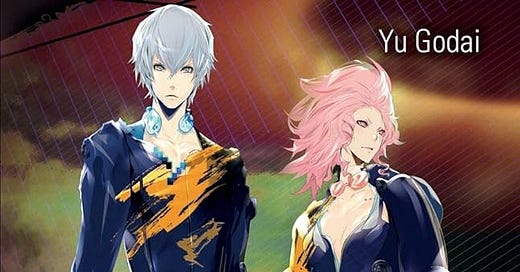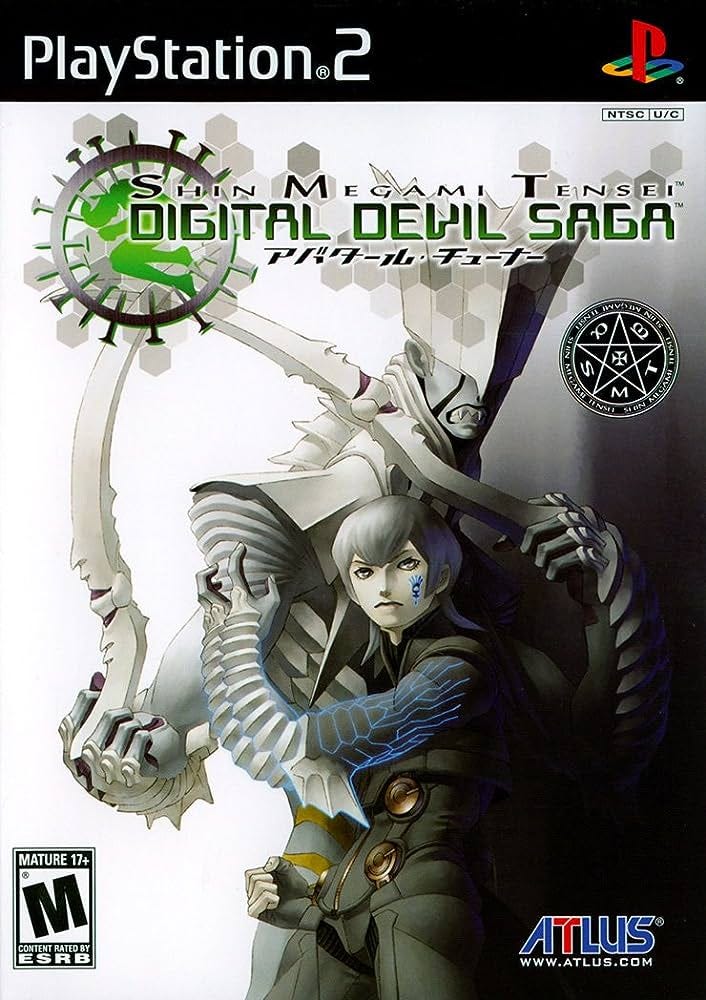In a land known as the Junkyard, rain falls without end as tribes war with each other to win the right to reach the promised land of Nirvana. Overseeing this endless conflict is the Church of the Arbiters of Karma. Welcome to the world of Quantum Devil Saga, a series of five Japanese novels.
The status quo of the Junkyard is destroyed by the appearance of the bizarre Atma virus, which grants everyone the ability to turn into powerful beings known as Asura. However, cannibalism is now required not only to grow more powerful, but to avoid losing all sanity and becoming a mindless beast. Additionally, the inhabitants of the Junkyard begin experiencing emotions and self awareness for the first time thanks to Atma.
In the same incident where Atma is unleashed, the Embryon tribe find an amnesic girl named Sera, who remembers only her name and that she came to save everyone. Contact with her blood allows one to maintain their sanity without resorting to cannibalism. The church announces that bringing Sera to them is now necessary to reach Nirvana.
Serph, the leader of the Embryon and protagonist of the story, has no intent on giving up Sera to the church or the other tribes who may exploit her for the power of her blood. This is the core conflict of the story, the Embryon seeking to protect Sera and finally reach Nirvana amidst the chaos wrought by Atma.
Something that becomes clear to readers fast is how odd the Junkyard is. Sera knows basic things that nobody else in the Junkyard does, like that cities are supposed to be places where people live. Even the first page of the book has Serph perplexed by seeing a cat, which he has no frame of reference for yet somehow knows what to call it
In addition to Serph, other notable members of the Embryon include Heat, a long time comrade of Serph who is eager to embrace the new role of cannibalism in the Junkyard, and Argilla, who refuses to devour her enemies and despises Atma. Naturally the two argue, with Heat making the case that Argilla is ultimately still feeding off of someone else, namely Sera.
There’s also Gale, Serph’s second in command who is the slowest to awaken to emotions and often declares his lack of comprehension for the emotion driven actions of others. Cielo is the youngest and most cheerful named member of the Embryon who helps lighten up the mood.
While the books do feature plenty of Asura battles that don’t shy away from getting gruesome, there’s a strong focus on introspection and interaction. It gives the characters and readers time to think instead of going from fight to fight. The battles and conversations are equally memorable to me, there’s a reason I mentioned a specific argument Heat makes.
Perhaps the biggest sell I can give for these books is that when referring back to them in order to check my terminology, I ended up reading entire chapters. The reread impulse was too strong.
Behind the Story
I’d like to take a brief detour for the history behind these novels. The author, Yu Godai, was involved as a story writer on the Digital Devil Saga games from Atlus, but she had to leave the project due to health issues. However, her contract let her write her own take on the story in book form, leading to Quantum Devil Saga.
Digital Devil Saga is one of many spin-offs for Shin Megami Tensei, a long running RPG franchise that itself began as a video game adaption of a novel, Digital Devil Story: Megami Tensei. With the similar titles I imagine the relationship between Digital and Quantum Devil Saga was a deliberate call back to the root of the franchise.
The mythological and religious focus of Shin Megami Tensei is present in the Devil Sagas as well. The Atma virus refers to the Sanskrit word ātman, often translated as soul or self. Characters assume their Asura form by reciting the mantra ‘om mani padme hum.’ Sectors of the Junkyard are named for different chakra, with the Embryon based in Muladhara.
Each character’s Asura form is also named for a mythological figure. Interestingly the English versions of the games and novels spell the name of Serph’s Asura self differently, though my understanding is that the book’s spelling of Varuna is more faithful. And as you can see there’s a particular focus on drawing from Indian traditions.
Serph has another much more notable difference between the sagas, his voice. In Digital Devil Saga Serph is a classic silent projector screen JRPG protagonist, while as a novel protagonist Serph in Quantum Devil Saga talks, and a lot of space is given to his contemplation.
I’ve never been a fan of silent protagonists, so I prefer book Serph. Comparing the opening acts of the games and book really had me feel the absence of Serph’s personality.
However, Digital and Quantum Devil Saga are not adaptations of each other. It feels more accurate to call them different takes on the same story. The differences between them are more a case of things diverging than an adaptation changing things, hence the similar yet different names.
State of the Saga
So far only two of the five novels have been translated, which cover the Embryon’s battle in the Junkyard to protect Sera and reach Nirvana. The third book is a lengthy flashback to explain the origins of the Junkyard, while the final two books bring the saga to its close.
Unfortunately, it looks as though it will be a long time until the full saga is translated. There has been no word on an official translation for the third book, and the fan translation of it has been acknowledged and given approval by the official translator of the first two, which does not strike me as a vote of confidence in an official translation happening.
Quantum Devil Saga volume 2 also did not have the best handled release. As someone who was anticipating the book it was difficult to find information on when it would release. Even now the website of its English publisher, Bento Books, makes no mention of volume 2. As a small publisher it’s understandable some minor hiccups might happen, but it’s been over five years and you’d have to scroll through their twitter to know Quantum Devil Saga 2 was ever published by them.
It’s also difficult to grab a print copy of the books now. It doesn’t appear ebook versions were ever made available either. It’s upsetting to see a quality series like this get treated so poorly, and a good reminder of why ebooks are good to have as an option.
With no remaining faith in it happening officially, I ended up reading not just the in progress fan translation of the remaining books, but also fan made summaries of the last three novels. The narrative of the latter half of the saga left an impact on me even in that second hand state. Makes me hope I can experience it all in the proper prose someday, all the way to the epilogue centered around a discussion of philosophy, as unlikely as that now seems.
If you can get your hands on Quantum Devil Saga it’s a great read, and a sample for the first as well as an interview with the translator is available on the website for Bento Books. You’re going to have to use any means necessary to read anything more however. But I know for me it’d be worth it.
Optional Response Prompt: Are you interested in anything cut off by a language barrier?





Love this sort of Japanese nonsense (affectionate). Shame about the release, but I am impressed it got any sort of release in the West. I've tried learning Japanese in order to gain access to just this sort of region-locked material. Unfortunately, I am very bad at learning languages and have not been able to achieve reading comprehension. Maybe someday...